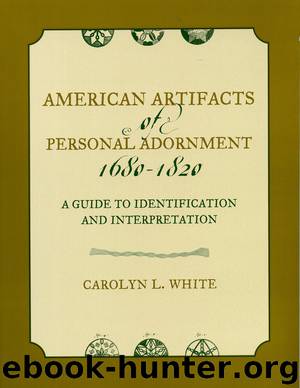American Artifacts of Personal Adornment, 1680-1820: A Guide to Identification and Interpretation by White Carolyn L

Author:White, Carolyn L. [White, Carolyn L.]
Language: eng
Format: epub
ISBN: 9780759114654
Publisher: AltaMira Press
Published: 2013-06-24T16:00:00+00:00
FIGURE 3.33. Bone buttons recovered in Portsmouth, New Hampshire. A. Bone button mold with beveled edge to receive stamped-metal cap. Lathe marks are visible on the surface of the button. B. Sew-through bone button. The center hole is a product of button production. (Photo by the author)
Shell Buttons. Shell buttons, often called “pearl” buttons because of their pearl-like luster, are made of mother-of-pearl, or shell. Shell was an expensive raw material in the eighteenth century because each shell yielded only a small amount of desirable material (the area between the outer lip of the shell and the edge of the scar where the foot attached). The most desirable and most expensive shells were obtained from East India; other less expensive ones were obtained from Manila, the Red Sea, or the Persian Gulf. Beginning in 1800, shell buttons were made in Ohio and the Midwest. Claassen has traced the development of shell buttons manufactured in the Mississippi watershed from the mid-nineteenth to mid-20th centuries.172
Shell buttons could be made in two different ways. In the first method, the shells were prepared by washing them, treating them with acid, and sawing them into squares that were then rounded into button blanks. In the second method, the shell button blanks were cut from the shell using a tubular saw that was fitted with a shank. The waste material from buttonmaking was used for cutlery or for small shirt buttons.173
Shell button shanks were metal pins that were inserted into the back of the button into a drilled shank hole to form a loop shank (figure 3.34).174 Alternately, two or four holes were drilled in the blank to make a sew-through button.
The design on shell buttons was engraved or cut into the button face, and the button was polished with soap and rottenstone. Shell buttons were sometimes decorated with cut steel, paste, or chased copper ornamentation or set with small seed pearls. The back of the button was frequently left in its natural state.175
Large shell buttons were fashionable in the late eighteenth century. These buttons typically measured approximately 36 mm in diameter.176
Horn Buttons. Horns and hooves were used to make buttons in the mid- to late eighteenth and early nineteenth centuries. Horn buttons were not fashionable but were inexpensive. Horn was used to make molds for covered buttons or sew-through buttons; shanked horn buttons were not made until the mid-nineteenth century.177
The horn button industry was a sideline to the horn comb industry and was developed in America in Newbury, Massachusetts, in 1759 by Enoch Noyes.178 When horn is heated and softened, it can be bent into any shape and can also be dyed any color. In the early part of the nineteenth century horn buttons were molded by hand with a press that made six, eight, and twelve buttons. The press consisted of two iron plates attached to two long handles with steel dies for casting the buttons. The mold was heated, and a flattened piece of horn was placed over the dies in the mold.
Download
This site does not store any files on its server. We only index and link to content provided by other sites. Please contact the content providers to delete copyright contents if any and email us, we'll remove relevant links or contents immediately.
| Beadwork | Jewelry |
| Rock & Gem Crafts |
On Writing A Memoir of the Craft by Stephen King(4892)
The Doodle Revolution by Sunni Brown(4713)
A Simplified Life by Emily Ley(4130)
Mummy Knew by Lisa James(3655)
Marijuana Grower's Handbook by Ed Rosenthal(3643)
Better Homes and Gardens New Cookbook by Better Homes & Gardens(3547)
Figure Drawing for Artists by Steve Huston(3409)
Paper Parties by Erin Hung(3398)
Draw Your Day by Samantha Dion Baker(3319)
The Genius of Japanese Carpentry by Azby Brown(3254)
Japanese Design by Patricia J. Graham(3138)
The Code Book by Simon Singh(3138)
Dangerous Girls by Haas Abigail(2997)
Lions and Lace by Meagan Mckinney(2941)
The Curated Closet by Anuschka Rees(2940)
How to Make Your Own Soap by Sally Hornsey(2867)
The Checklist Manifesto by Atul Gawande(2810)
The Wardrobe Wakeup by Lois Joy Johnson(2754)
Zero to Make by David Lang(2753)
